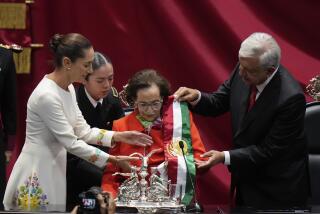‘Iron Butterfly’ Described as Stumbling Block to Departure
- Share via
To the end, Imelda Marcos apparently still thought she could succeed her beleaguered husband, Philippine President Ferdinand E. Marcos.
The former beauty queen, who masked considerable political ambition beneath exaggerated expressions of her femininity--earning her the nickname “Iron Butterfly”--was “one of the main stumbling blocks” to her husband’s resignation and departure from their homeland, according to a congressional source in Washington who declined to be identified.
“Apparently, she wanted to stay and hoped to succeed him eventually,” said the source, who was close to the negotiations between the United States and both Marcos and his opposition in recent days.
Force Behind President
Imelda Marcos, 56, had long been seen as the driving force behind her husband. Rumors that she wanted to succeed him have been common in recent years as Marcos’ ill health became increasingly apparent.
When Marcos announced last November that he would hold a special presidential election this month to appease critics and demonstrate his popularity, many Filipinos suggested that he might pull out at the last minute and substitute his wife’s name for his on the ballot.
However, the First Lady repeatedly denied harboring presidential ambitions, declaring in 1982, “I would be a freak of a woman if I became president.”
Imelda Marcos was born July 2, 1929, into the politically prominent Romualdez family.
When she was 8, the family moved to Tacloban in the central Philippines. Sometimes she walked barefoot to market, she later recalled. But at 18, her pretty face, fair skin and long legs won her the beauty title “Rose of Tacloban.”
Those physical attributes plus an attractive singing voice won her another beauty title on her return to Manila four years later. There, after working at a music store and in the Central Bank, she married war hero Marcos, then a congressman, in 1954, when she was 24.
In her, the Philippines had a First Lady who did more than cut ribbons and smile at official functions. She applied boundless energy to cultural, social and political work, spending $700 million in 10 years on her pet projects.
Envoy for Her Husband
Imelda Marcos also served as a foreign envoy for her husband, making up to 15 foreign trips in one year. She was officially credited with breaking the ice between the Philippines and the Soviet Union and China.
She also held political office after Marcos declared martial law in 1972. He named her governor of metropolitan Manila in 1975 and minister of human settlements three years later. Her Cabinet ministry boasted of building thousands of homes and lending millions of dollars for small businesses. But critics repeatedly charged that the money was siphoned off by corrupt cronies of the Marcos regime or government officials.
Concern for the Poor
Some praised her for her concern for the poor and for trying to revive a national culture diluted first by Spanish and then by U.S. colonial rule.
Her critics denounced her for a life style in sharp contrast with her humble childhood and the poverty that prevailed in the country. When she stayed at New York’s Waldorf-Astoria Hotel, for instance, staff members there said she ordered $400 worth of flowers put in her rooms each day.
Publicly, she always deferred to her husband. In an interview before the Feb. 7 election, when criticizing candidate Aquino for her ambition, she said that women have their place in the home and are incapable of holding political office.
In the Philippines, she said, “Power is always the man. Power and strength is man. Beauty, inspiration, love is woman.”
More to Read
Sign up for Essential California
The most important California stories and recommendations in your inbox every morning.
You may occasionally receive promotional content from the Los Angeles Times.













